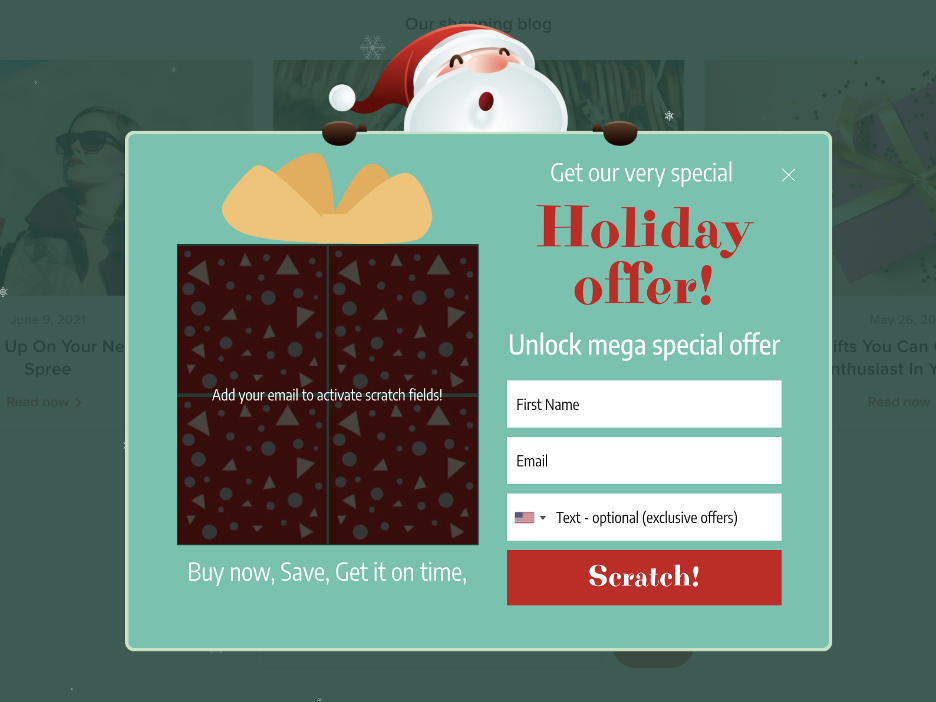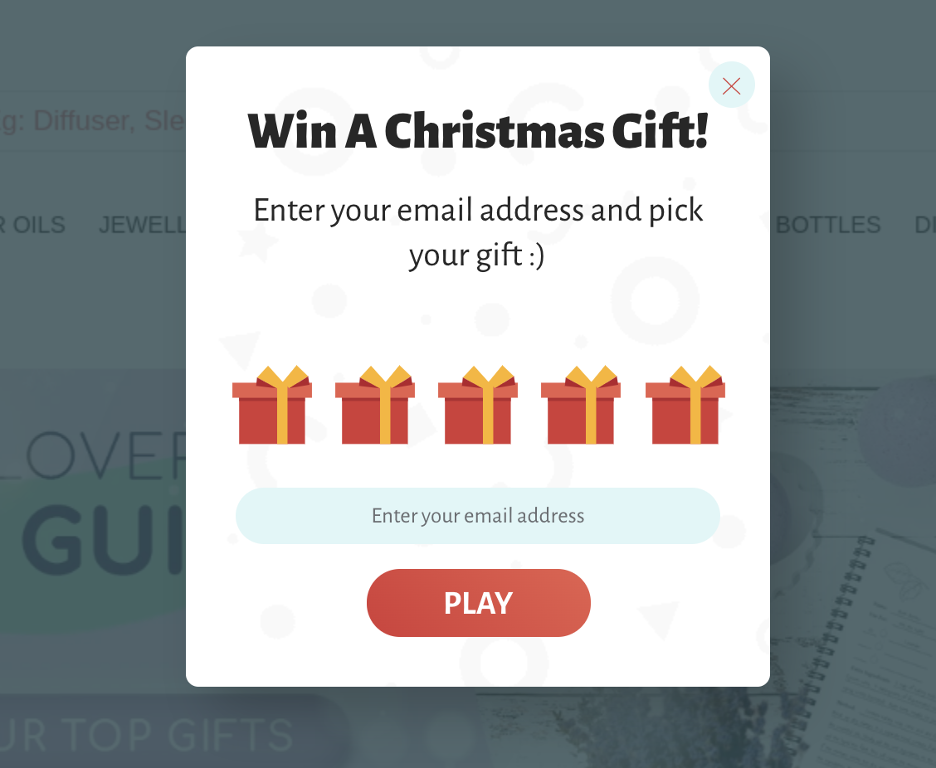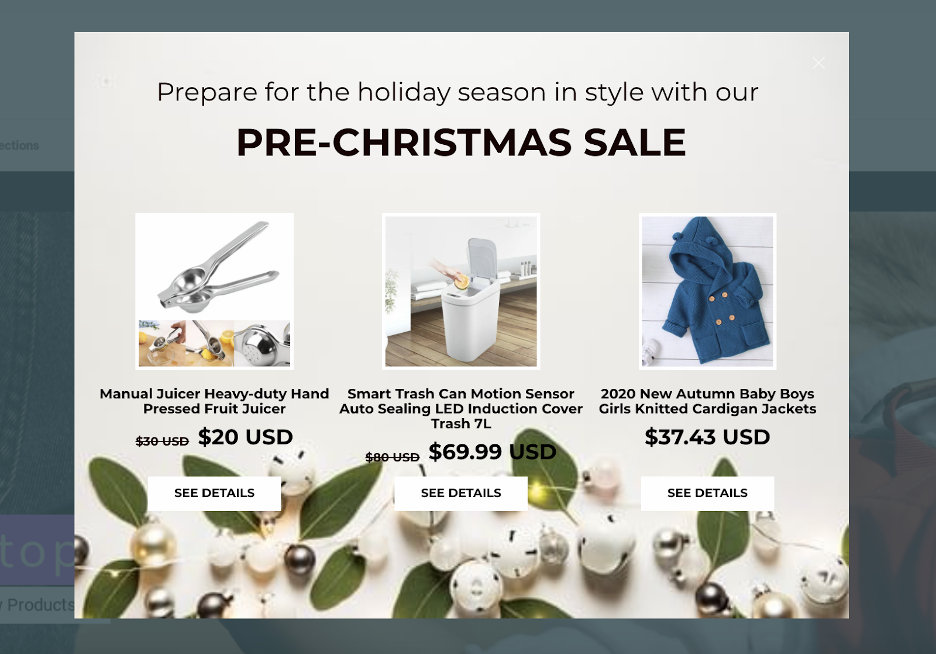- Blog
- Christmas Popups: 14 Creative Examples & 24 Free Templates
Christmas Popups: 14 Creative Examples & 24 Free Templates
-
Nikolett Lorincz
- Conversion
- 6 min read
Table of Contents
Christmas is a time of joy, celebration, and connection, making it the perfect season to captivate your audience with festive creativity.
For businesses and marketers, the holiday season presents a unique opportunity to engage customers in fun, memorable ways. One powerful tool to achieve this is using Christmas pop-ups, a versatile and visually striking element that can improve your website, boost conversions, and spread Christmas cheer.
In this article, we’ve compiled 14 of the most creative Christmas popup examples we’ve seen—complete with templates to inspire your own festive designs.
Whether you’re looking to increase sales, grow your email list, or simply share the holiday spirit, these holiday pop-ups are sure to spark ideas for your seasonal campaign.
Let’s dive in!
Why are popups important during the holiday season?
Every visitor has their own specific needs, and it’s your job to make sure you truly understand those needs.
Studies show that consumers are more likely to buy from a company that provides a tailored experience.
In fact, 66% of customers expect companies to understand their unique needs and expectations. And 70% of consumers say that how well a company understands their individual needs impacts their loyalty.
With this in mind, personalized popups become an invaluable tool for meeting these expectations and boosting engagement.
By using personalized popups, you can create customized holiday experiences that resonate with each visitor.
Whether it’s greeting a returning customer with a special Christmas discount or offering personalized product recommendations (e.g. promoting seasonal drinks like hot chocolate or gingerbread milk punch to create a festive atmosphere), these popups make your shoppers feel valued and understood, increasing their likelihood of making a purchase.
In addition to personalization, holiday-themed popups with eye-catching designs encourage users to interact with your content, boosting conversions and customer retention.
They also provide a perfect platform for time-sensitive offers. By incorporating countdown timers or exclusive discounts, popups create a sense of urgency that encourages customers to take swift action, ensuring they don’t miss out on holiday deals.
In short, personalized popups help create a memorable, relevant, and immersive experience during the holidays, while driving loyalty and increasing conversions at a time when customer attention is at its peak.
Christmas popup examples and tips
Over the years, we’ve been blown away by the festive, Christmas-themed pop-up campaigns that OptiMonk users come up with.
That’s why today, we’re sharing 7 specific ways you can use popups on your site with 14 creative seasonal examples. Ready to add some holiday cheer to your website?
1. Encourage new visitors to sign up for your email newsletter
The most basic popup personalization involves differentiating your new visitors from your returning visitors.
Returning visitors are more aware of your products and services, while new visitors are likely still browsing around and getting to know you.
Maybe they had a problem, searched for a solution on Google, and landed on your site. Or maybe one of your Facebook ads got their attention. But what’s almost certain is that they’re probably not ready to buy quite yet.
After these new visitors have a look around your website, you can encourage them to subscribe to your email list with some kind of incentive. This way, you’ll be able to keep in touch with them and nudge them towards a purchase in the future.
Plus, most ecommerce stores have more new visitors than usual around the holidays. Take advantage of that extra traffic to grow your email list! This approach can also help you drive sales throughout the rest of the year since your marketing emails will reach more inboxes in January, February, and beyond.
This is exactly what Topperswap did using a Christmas popup with a holiday cheer design.
The message, “Congratulations, you’ve unlocked a secret discount code,” makes the offer even more special because it seems like it’s not available for everyone.

Spread A Little Hope and Joy used a similar tactic, but they went with a Buy One Get One Free (BOGO) offer as an incentive.
Visitors love to see a BOGO offer because it feels like an even better deal than a percentage discount.
And since it’s such a good deal, visitors will be more willing to enter their email addresses in order to take advantage of it. This means the company will be able to grow their email list while increasing revenue at the same time.

Love the look of the two campaigns above? You can use it with just one click:
BlendJet, on the other hand, went with a volume discount. They offer different levels of discounts based on the number of items a customer buys. This is a great strategy during the holidays, when customers might buy the same gift for multiple people.
This not only encourages your customers to buy more but also increases your average order value.

You don’t necessarily need to use a Christmas-themed design for your holiday campaigns. After all, the look doesn’t work equally well for all brands.
This email capture popup from Gwl Fitness doesn’t feature any holiday imagery, but they still highlight “Holiday deals” in their copy. This tells visitors that there are items on sale during the season.

2. Gamify the user experience
Gamification helps to turn your visitors’ interaction with your website into an unforgettable experience.
These kinds of popup campaigns work better for visitors who aren’t very familiar with your products yet. You can display a gamification popup sooner than an email popup offering a discount.
There are many ways to apply gamification to your website. Let’s take a look at a few!
SkyMall uses a gamification template that we call the scratchcard. It’s a great way to collect email addresses and phone numbers while creating a fun, enjoyable user experience.
SkyMall not only asks for email addresses but also phone numbers. Notice how the phone number is optional but promises exclusive offers? Great tactic!

You can try SkyMall’s scratchcard strategy on your own website with our ready-to-use template:
Lucky wheels are one of the most popular types of gamification templates. These fun, engaging gamified popups convert much better than regular email popups (13.23% vs 5.10% conversion rate on average).
Holy Class Cosmetics uses a lucky wheel with bright pink coloring that’s consistent with their branding. They give it a holiday spin with the snowflakes and “Merry Christmas” text.

Vivian Rose & Co. also used a lucky wheel campaign. From the subtle holiday theming to the great use of a color gradient on the “Spin!” button, everything just works.

If you like the idea of a lucky wheel, try it out with one of the pre-made templates below:
Love Thy Oils uses a different gamification popup that’s especially fitting for the holiday season. The “Pick a Gift” template lets users reveal a discount code in exchange for entering their email addresses.
The popup’s minimalist design is very effective, with the “Christmas Gift” messaging and little gift boxes working together perfectly.

Try the Pick a Gift strategy on your own website with our ready-to-use template:
3. Recommend products for visitors browsing your product pages
Showing relevant recommendations to your visitors based on their behavior and interests is one of the best ways to use personalization.
You have lots of options here. You can recommend products that are similar to the ones your visitors are browsing, you can promote your best-selling products, or you can recommend products that are on sale right now—and that’s just a few examples!
Check out how Virgostop promotes their discounted holiday items on a Christmas pop-up below.

Product recommendation popups like this one are a great way to increase your store’s average order value. They help customers who are shopping for a certain item find other things they might like (and buy)!
Iron Rose Home uses a holiday-themed recommendation popup when their visitors show exit intent (when they’re about to leave the site). Exit-intent popups can stop visitors in their tracks and draw them back in so they continue shopping.

Give product recommendation popups a try with one of these ready-to-use holiday pop-up templates:
4. Inform returning visitors about your sale
You don’t want to show an email subscription popup to your returning customers who’ve already subscribed, but you still want to inform them about your sale.
This is where a simple informational campaign comes in handy.
Grosarget just wants to make sure that their visitors are aware of their sales, so they go ultra minimal. They simply feature a big “-40%” and a follow-up sentence letting visitors know the discount applies to everything on their site.
We’ve seen tons of unique popups, but none quite like Grosarget’s. Check out how they created a Christmas tree from their products, complete with boxes for the stem!

Would you like to announce your Christmas sale to returning visitors? Try these Christmas pop-up templates:
Sticky bars are another great way to inform returning visitors about your sale:
5. Promote free shipping on a sticky bar
Buckaroo Bling uses this sticky bar to promote their free shipping offer in the days leading up to Christmas. And to top it off, they’re also upgrading everyone’s free shipping to Priority Mail.
The holidays are the perfect time for an offer like this, since there will always be people who are ordering their gifts a little bit late and want to make sure they’ll arrive on time.

6. Stop cart abandoners with exit-intent popups
Cart abandonment popups are also a useful addition to your site during Christmas. These exit-intent popups can encourage visitors who’ve added items to their cart to complete their purchase rather than leaving.
The “15% off & free shipping” offer gives visitors an extra incentive to check out, while the countdown timer adds a sense of urgency.

You still have time to set up cart abandonment popups for your Christmas sale with these pre-made templates:
7. Engage visitors with quiz popups
Quiz popups are a fun and interactive way to engage your visitors, especially during the holiday season when customers are in a festive and playful mood.
These popups allow you to ask personalized questions to better understand your audience, recommend the perfect products, and keep your visitors entertained.
Quizzes are a great way to guide visitors through their shopping experience by asking questions about their preferences, gift recipients, or holiday needs.
In addition, quiz popups can be used to segment your audience and gather valuable data about their interests. By learning more about your customers, you can provide them with tailored email follow-ups, exclusive offers, and personalized shopping experiences that keep them coming back.
Try adding these holiday-themed quiz pop-up templates to your site:
+1 Encourage visitors to return to your site
Gutsy Goodness created a campaign that promotes “12 Days of Christmas.” This is a great tactic because it entices visitors to come back to their site every day. Since consumers never know what the deal is going to be, they’re always going to be curious to check it out!
They also added a countdown timer that displays how much time is left to take advantage of the daily deal. This creates a sense of urgency that nudges visitors to buy now rather than later.

Wrapping up
The holiday period can make or break an online store’s entire year. It’s crucial to use personalized popups to take full advantage of the season!
You’ll see a difference in your conversion rate when you use exit-intent popups for cart abandoners and a spike in email subscribers after you install a lucky wheel for new visitors.
Hopefully, the real-life examples above have given you plenty of inspiration for your own seasonal campaigns. Remember, your store’s seasonal goals should help you choose what kind of messages to use.
There’s not much time left! If you haven’t yet rolled out your Christmas popup campaigns, head on over to OptiMonk’s template library and pick some out now!
Migration has never been easier
We made switching a no-brainer with our free, white-glove onboarding service so you can get started in the blink of an eye.

What should you do next?
Thanks for reading till the end. Here are 4 ways we can help you grow your business:
Boost conversions with proven use cases
Explore our Use Case Library, filled with actionable personalization examples and step-by-step guides to unlock your website's full potential. Check out Use Case Library
Create a free OptiMonk account
Create a free OptiMonk account and easily get started with popups and conversion rate optimization. Get OptiMonk free
Get advice from a CRO expert
Schedule a personalized discovery call with one of our experts to explore how OptiMonk can help you grow your business. Book a demo
Join our weekly newsletter
Real CRO insights & marketing tips. No fluff. Straight to your inbox. Subscribe now
Nikolett Lorincz
- Posted in
- Conversion
Partner with us
- © OptiMonk. All rights reserved!
- Terms of Use
- Privacy Policy
- Cookie Policy
Product updates: January Release 2025









